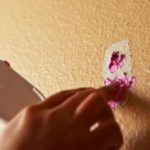By Daniel Bortz
Congratulations: You’re moving out, and on to your next home! Now all you have to do is pack up your things and skedaddle, right?
Not so fast. If you’re still trying to sell your current home, you’ll want to make sure it looks its best, which means you might have to make a few repairs. And there’s no better time to do this than after you’ve removed all your boxes and furnishings since this means you’ve got plenty of space to get the job done right (and with minimal mess).
Granted, you might have already made some upgrades during the early stages of sales prep … but moving out means you could uncover a whole lot more. And trust us, buyers will notice!
Of course, if you’ve already sold your home, you’re off the hook … but if not, it will behoove you to do these seven upgrades after moving out. Don’t worry, they’re fairly easy, and they’ll make a big difference helping you find a buyer who’ll pay top dollar.
1. Patch holes in walls
Seeing walls with holes—even small holes left by nails—is an immediate turnoff to home buyers, says Sarah Fishburne, director of trend and design at The Home Depot. But you don’t have to repaint your entire house to have your home looking fresh again. A little spackling, followed by spot painting—a cinch if you’ve kept some original paint—will do the trick. (If you don’t have any leftover paint, peel a dollar-size piece from the wall and bring it to the paint store so they can match the color for you.)
If you have only a few holes and scratches, you can fill them with spackling compound, which is sold in small quantifrecities. For a greater number of gashes or holes, use joint compound, which is sold in quarts or 5-gallon buckets.
2. Add a fresh coat of paint to rooms that are outdated or painted in loud colors
Love that plum paint color you chose for your master bedroom? Home buyers might not! The good news is, painting a room is an easy, low-cost project you can do yourself. Selecting the right hue, though, is crucial.
“Neutral colors are generally the safest choice, as they blend with many different decor styles,” says Hunter Macfarlane, Lowe’s project expert. “Gray is a popular color to paint a room before selling, as it gives the walls depth while still tying furniture and other decor items together.”
Moreover, “a fresh coat of paint never hurt resale value,” Fishburne says.
3. Replace old outlet wall plates
This is another quick and budget-friendly way to make a space feel cleaner and updated, Macfarlane says. Proceed with caution, however: Old wall plates can be a fire hazard if they’re cracked or damaged in any way. If you suspect there’s an issue, hire an electrician to replace the wall plates for you.
4. Clean carpeting
Dirty and dingy carpets are huge eyesores, which is why David Pekel, chief executive officer at the National Association of the Remodeling Industry, recommends that homeowners give their house’s carpeting a good cleaning after moving out. You can amp up your vacuum with rug-cleaning products such as powders, foam sprays, and liquid shampoos available at grocery and hardware stores. For stained areas, use a bristled brush to work the cleaning solution into the carpet before allowing it to dry and then vacuuming up.
To remove embedded dirt, you may need to use a powerful industrial-style carpet-cleaning machine, like a Rug Doctor, which sprays hot water with a detergent over the carpet and extracts it with a high-powered vacuum. Industrial carpet cleaners have more washing and sucking power than most consumer carpet cleaners, but they’re expensive to buy—about $400 to $700—so it’s more economical to rent one from a hardware store for about $25 to $30 per day.
5. Clean hardwood floors
Many home buyers swoon over hardwood floors. So if you have them, make sure they’re glistening after you move out.
“Wood is probably the easiest floor covering to keep clean, but you have to use the right cleaning products,” says Brett Miller, vice president of education and certification for the National Wood Flooring Association in St. Louis.
Most wood floor installers or manufacturers recommend cleaners that contain isopropyl alcohol, which dries quickly, and are available at home supply stores. To make your own solution, simply add a capful of white vinegar to a gallon of water, which will help dissolve grease and grime on the floor but won’t strip the finish. To remove shoe scuffs, rub marks with a tennis ball, which cleans without scratching the finish.
Under no circumstances should you use a steam mop, Miller warns.
“Steam is horrible for wood floors. It opens the pores in woods and damages the finish, causing irreversible damage to any wood floor,” he says. Here’s more on how to clean hardwood floors.
6. Replace or refresh old hardware
Swapping out old cabinet and door hardware is a simple, low-cost project you can tackle in a day that will make your home more visually appealing. All you need is a screwdriver and a free afternoon. Want to save some money? Keep your existing hardware and give it a makeover with spray paint—a few light coats can breathe new life and personality into rusty old knobs and pulls.
7. Improve the look and functionality of your master bathroom
A full bathroom remodel is expensive; on average, it costs $10,344, according to HomeAdvisor. Just a few changes to your master bathroom, though, can make it one of the most stylish rooms in your house.
Simple touch-ups, like regrouting and recaulking bathroom tile, will make the room look newer. In addition, swapping out inefficient toilets, faucets, and showerheads for products that aid in water conservation can add real appeal to prospective homebuyers who are looking to lower their water footprint (and lower their water bill!). A low-flow toilet, for example, uses 20% less water than a standard toilet, and water-saving showerheads can help families save almost 3,000 gallons of water a year.





